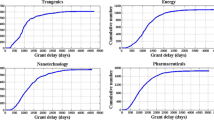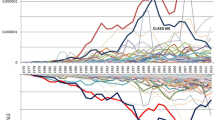Abstract
Information spectra are defined as intervals between equivalent information events. Their relations to negative binomial and negative polynomial distributions and urn models are explained. Basic properties of empirical information spectra from patent literature are shown and discussed in connection withHaitun's views on Z type information distributions,Sichel's GIGP model andTrofimenko's study on formation and decay of author groups.
Similar content being viewed by others
References
D. DE S. PRICELittle Science, Big Science, Columbia University Press, New York-London, 1963, p. 42.
A. SCHEELINE, Implications of line number to line intensity logarithmic relationship for emission spectrochemical analysis,Analytical Chemistry, 56 (1986), 802.
A. A. MARKOV, An example of statistical study of the text “Evgenij Onegin” illustrating connection of experiments into a chain (In Russian),Bull. Acad. Imp. Scient. de St Pétersbourg, Ser. VI. (1913) 153.
S. D. HAITUN, Stationary scientometric distributions, Part I. Different approximations,Scientometrics, 4 (1982) 5.
S. D. HAITUN, Stationary scientometric distributions, Part II. Non-Gaussian nature of scientific activities,Scientometrics, 4 (1982) 89.
S. D. HAITUN, Stationary scientometric distributions. Part III. The role of the Zipf distribution,Scientometrics, 4 (1982) 181.
S. D. HAITUN, The rank distortion effect and non-Gaussian nature of scientific activities,Scientometrics, 5 (1983) 375.
S. H. SICHEL, The GIGP distribution model with aplications to physics literature.Czechoslovak Journal of Physics. B 36 (1986) 133.
D. DE S. PRICE, A general theory of bibliometric and other cumulative advantage processes,Journal of The American Society for Information Science, 27 (1976) 292.
A. RENYI,Wahrscheinlichkeitsrechnung, Deutscher Verlag der Wissenschaften, Berlin, 1962.
M. KUNZ, Time distribution of patent information,Scientometrics, 1 (1979) 275.
M. KUNZ, Information processing in linear vector space,Information Processing and Management, 20 (1984) 519.
M. KUNZ, On entropy in physics and information,Czechoslovak Journal of Physics, B 36 (1986) 81.
D. DE S. PRICE, Cumulative advantage urn games explained. A reply to Kantor,Journal of the American Society for Information Science, 29 (1978) 204.
J. TAGUE, The success-breeds-success phenomenon and bibliometric processes,Journal of the American Society for Information Science, 32 (1981) 281.
I. MIKEŠOVÁ, M. KUNZ, Patent activity in plastic branch (In Czech),Chemický průmysl (Chemie a lidé) 30 (1985) 5.
D. SINGH, R. P. MERRILL, Molecular weight distribution of polyethylene produced by Ziegler-Natta catalysts,Macromolecules, 4 (1971) 599.
A. P. TROFIMENKO, Formation and decay of author /groups in Physics,Czechoslovak Journal of Physics, B 36 (1986) 180.
Author information
Authors and Affiliations
Rights and permissions
About this article
Cite this article
Kunz, M. Time spectra of patent information. Scientometrics 11, 163–173 (1987). https://doi.org/10.1007/BF02016589
Received:
Revised:
Issue Date:
DOI: https://doi.org/10.1007/BF02016589




